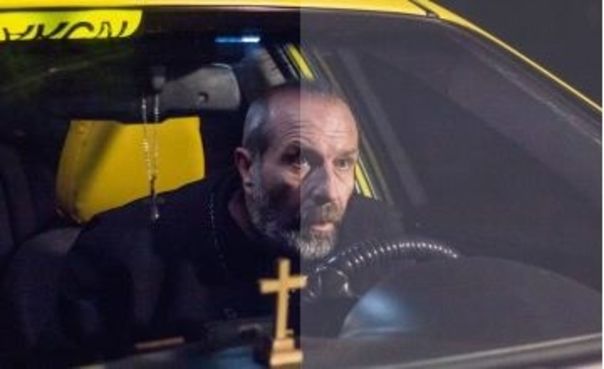Review: DIRECTIONS / POSOKI
By Flavia Dima

Stephan Komandarev’s newest feature is a crowning achievement of cinema: stellar performances, flowing (and, at times, gravity-defying) cinematography and brilliant script writing make for a memorable title from what seems to be an emergent Bulgarian New Wave.
After its world premiere at Cannes’ Un Certain Regard section, Stephan Komandarev’s latest work, DIRECTIONS / POSOKI (2017) had its regional premiere at Sarajevo Film Festival as an entry in this year’s main competition – where it may, indeed, be one of the strongest contenders for the Heart of Sarajevo, the festival’s top award. Composed of several vignettes, following several cab drivers across one single night, DIRECTIONS explores timeless themes such as human compassion and corruption, mortality and morality, revenge and redemption, while simultaneously paying homage to the work of filmmakers like Jim Jarmusch, Jafar Panahi, and Abbas Kiarostami. Although the alert magic realism of his 2008 THE WORLD IS BIG AND SALVATION LURKS AROUND THE CORNER / SVETAT E GOLYAM I SPASENIE DEBNE OTVSYAKADE seems to have faded (save for the final sequence), Komandarev sets himself apart as a keen observer of human nature, in a tone that is simultaneously hilarious and grim.
The backbone of DIRECTIONS lies in its classically-structured script that cleverly uses literary devices such as narrative circularity, shifting perspectives, real-time action, along with framing the story with the help of a prologue and epilogue. The opening scene sets both the tone and introduces the recurring themes of the film – we follow taxi driver Misho (Vassil Vassilev) as he is driving his teen daughter to school before an important meeting. Although he seems guided by a very strong moral compass, which we see at work in a confrontation with a young prostitute who tries to skip class, by the end of the almost 10-minute-long sequence, we witness him attempting suicide after fatally shooting a loan shark. After he fails to gather an ever-increasing sum to bribe the local mafia, seen here as an endemic cancer of Bulgarian society which basically controls both the local laws and economy, Misho snaps. The question whether his actions are justifiable is one of the sub-narratives of the film, as he is faced with total repossession (which includes the small apartment he shares with his family) and enters into a coma.
Cut to night-time: five other taxi drivers are lurking around Sofia while listening to an almost non-stop radio coverage of Misho’s deed, with listeners chiming in with their colorful, sometimes aberrant opinions by telephone – a device which brings to mind Corneliu Porumboiu’s 12:08 EAST OF BUCHAREST / A FOST SAU N-A FOST? (2006). All five drivers have their heavy cross to bear (with one of them doing it in the most literal sense, since he is a priest by day). From personal grievances and dashed dreams to moments of compassion or rudeness, the drivers are seen interacting with a series of diverse patrons which bring forth both sides’ innermost emotions, beliefs and fears. Ranging from insanely funny to heart-achingly sad, while stopping through violence and vindication, the chance meetings between the drivers and their clients are profoundly imbued by the theme of death, as it rears its manifold heads into each of the tableaux which comprise the film. Although one might argue that the overarching theme of the film is the profound corruption which drives Bulgarians to either live in poverty or to flee the country, leaving it at the hands of unscrupulous, rampant capitalists and mafiosos, it is ultimately death, and not necessarily national identity politics, that brings the film’s characters together. But, as it is in the Balkans, everything comes together with a generous amount of black humor – have a drink every time one of the characters says a hilarious, witty one-liner and you probably won’t be able to leave the cinema on your own two feet.
One of the film’s masterstrokes is its cinematography, headed by Bulgarian director of photography Vesselin Hristov, known for his work on THIRST / JAJDA (2015). Each of the sequences is shot in single, uninterrupted handheld shots on an ARRI Alexa camera, which, at times, surpass ten minutes in length. The camera’s glance is fluid, giving the sense of being a witness to the film’s events – its biggest feat comes in the third vignette, as driver Zhoro (Assen Blatechki) cleverly tries to save a man from throwing himself off a bridge. With the scene already clocking in at more than five minutes in length, the camera suddenly detaches and glimpses at the characters from beyond the rails of the bridge, seemingly floating in mid-air.
The performances delivered by the film’s ensemble cast are also one of its strongest accomplishments, with actress Irini Zhambonas’ interpretation of Rada, a female taxi driver who gets a chance to enact a long-overdue revenge, coming across as one of the most memorable deliveries in DIRECTIONS.
Taxis (and cars, in general) have always been an iconic space in the history of cinema – it is as if they are mobile confessionals, whereby the small, enclosed space creates the perfect opportunity to delve deep within the corners of the human soul. Given its fine-tuned aesthetic details, the film comes across as an experience in itself: not only does the spectator get a bitter taste of the problems and profound discontent that are haunting the former Soviet states, you virtually become the front-seat passenger riding along with the characters on their voyages, be they physical or metaphorical. And it seems that Stephan Komandarev is painfully aware of this as his movie sprawls both across the streets of Sofia and amongst the highways of his protagonists’ hearts and minds. His strong command over both universal themes and particular social issues makes DIRECTIONS into one of this year’s most riveting discoveries.

